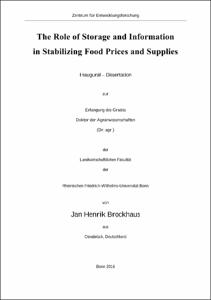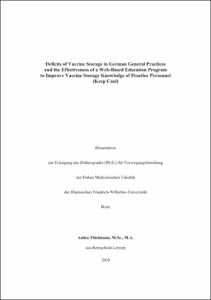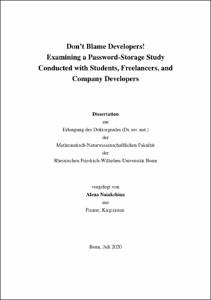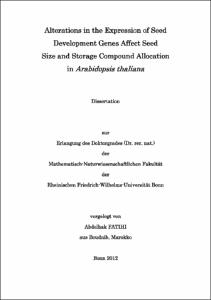Brockhaus, Jan Henrik: The Role of Storage and Information in Stabilizing Food Prices and Supplies. - Bonn, 2016. - Dissertation, Rheinische Friedrich-Wilhelms-Universität Bonn.
Online-Ausgabe in bonndoc: https://nbn-resolving.org/urn:nbn:de:hbz:5n-44445
Online-Ausgabe in bonndoc: https://nbn-resolving.org/urn:nbn:de:hbz:5n-44445
@phdthesis{handle:20.500.11811/6623,
urn: https://nbn-resolving.org/urn:nbn:de:hbz:5n-44445,
author = {{Jan Henrik Brockhaus}},
title = {The Role of Storage and Information in Stabilizing Food Prices and Supplies},
school = {Rheinische Friedrich-Wilhelms-Universität Bonn},
year = 2016,
month = aug,
note = {High and volatile food prices can push people into poverty, impact production and consumption, discourage investments, and lead to social unrest. Thus, due to occasional global food shortages as in 2007/08 and frequent regional shortages, many governments apply price stabilization policies. However, academic and political controversies about appropriate measures persist. This thesis explores the role of private and public storage, information, trade policies, international cooperation, and price-responsive production in stabilizing food prices.
In spite of its relevance for resource allocation, knowledge of the quality of global supply and demand estimates is limited. Hence, USDA, IGC, and FAO-AMIS estimates are compared using cointegration analysis, granger causality tests and three other methods. Estimation differences are found to be driven by methodological discrepancies rather than differing information. Differences are large for stocks and trade and persist over time revealing a comovement of the estimates. Averaging over sources can improve robustness and precision.
Despite its importance for the WTO and other trade agreements, knowledge of stabilization policies in an open economy is scarce. Additionally, private storage has been neglected in previous studies on international cooperation. Thus, emergency reserves, subsidized private storage, and strategic trade restrictions are compared in terms of their costs and impacts on price levels, volatility, and extreme events. A rational expectation partial equilibrium model is applied to capture dynamic interactions between agents. Private storage is found to be effective in reducing price volatility, whereas, complementarily, reserves are more effective in preventing extreme events. While free trade is usually beneficial, incentives for restricting exports may arise if stabilization policies are not aligned or the production variability differs too much. Asymmetric policies can explain large price increases as observed in 2007/08.
With some adjustments, the above model is used to present a new empirical validation method for the competitive storage model, the workhorse in numerical analysis of private storage. For the first time, the validation uses actual stock data. By applying a surface response methodology, this study derives a reduced-form equation which is shown to perform well as a surrogate model for private storage in theory and empirical tests. This allows directly quantifying stock determinants and facilitates high-dimensional modelling exercises.
As an empirical case study, India’s public stockholding program, which suffers from surging stocks and costs, is analyzed. Necessary reforms require understanding how policies impact stocks, which is quantified for the first time. Thus, expected policy impacts on public rice stocks are deduced from economic theory and tested empirically. Private stock determinants are quantified by combining the reduced-form storage equation with an instrumental variable approach. Public storage is found to be inert, lacking crisis-responsive consumer protection and driven by the minimum support price, market supply, and export bans. The 29% increase of the real support price in 2008 contributed 4.9 million tons to public stocks, the export ban another 2.9. Each ton of public stocks crowds out half a ton of private stocks; however, speculative storage activities persist. Policy makers seem to be unaware of the problematic policy interactions.
China’s demand growth and reluctance to rely on imports for its main food crops underline the need for a responsive supply, i.e. farmers making use of the latest price information. Hence, the time-dependent price responsiveness of supply is analyzed using the difference GMM estimator on province panel data. Production responds most to prices around planting time indicating the up-to-dateness of farmers’ price information. High temperatures reduce production thereby highlighting the importance of limiting climate change and adapting to it.},
url = {https://hdl.handle.net/20.500.11811/6623}
}
urn: https://nbn-resolving.org/urn:nbn:de:hbz:5n-44445,
author = {{Jan Henrik Brockhaus}},
title = {The Role of Storage and Information in Stabilizing Food Prices and Supplies},
school = {Rheinische Friedrich-Wilhelms-Universität Bonn},
year = 2016,
month = aug,
note = {High and volatile food prices can push people into poverty, impact production and consumption, discourage investments, and lead to social unrest. Thus, due to occasional global food shortages as in 2007/08 and frequent regional shortages, many governments apply price stabilization policies. However, academic and political controversies about appropriate measures persist. This thesis explores the role of private and public storage, information, trade policies, international cooperation, and price-responsive production in stabilizing food prices.
In spite of its relevance for resource allocation, knowledge of the quality of global supply and demand estimates is limited. Hence, USDA, IGC, and FAO-AMIS estimates are compared using cointegration analysis, granger causality tests and three other methods. Estimation differences are found to be driven by methodological discrepancies rather than differing information. Differences are large for stocks and trade and persist over time revealing a comovement of the estimates. Averaging over sources can improve robustness and precision.
Despite its importance for the WTO and other trade agreements, knowledge of stabilization policies in an open economy is scarce. Additionally, private storage has been neglected in previous studies on international cooperation. Thus, emergency reserves, subsidized private storage, and strategic trade restrictions are compared in terms of their costs and impacts on price levels, volatility, and extreme events. A rational expectation partial equilibrium model is applied to capture dynamic interactions between agents. Private storage is found to be effective in reducing price volatility, whereas, complementarily, reserves are more effective in preventing extreme events. While free trade is usually beneficial, incentives for restricting exports may arise if stabilization policies are not aligned or the production variability differs too much. Asymmetric policies can explain large price increases as observed in 2007/08.
With some adjustments, the above model is used to present a new empirical validation method for the competitive storage model, the workhorse in numerical analysis of private storage. For the first time, the validation uses actual stock data. By applying a surface response methodology, this study derives a reduced-form equation which is shown to perform well as a surrogate model for private storage in theory and empirical tests. This allows directly quantifying stock determinants and facilitates high-dimensional modelling exercises.
As an empirical case study, India’s public stockholding program, which suffers from surging stocks and costs, is analyzed. Necessary reforms require understanding how policies impact stocks, which is quantified for the first time. Thus, expected policy impacts on public rice stocks are deduced from economic theory and tested empirically. Private stock determinants are quantified by combining the reduced-form storage equation with an instrumental variable approach. Public storage is found to be inert, lacking crisis-responsive consumer protection and driven by the minimum support price, market supply, and export bans. The 29% increase of the real support price in 2008 contributed 4.9 million tons to public stocks, the export ban another 2.9. Each ton of public stocks crowds out half a ton of private stocks; however, speculative storage activities persist. Policy makers seem to be unaware of the problematic policy interactions.
China’s demand growth and reluctance to rely on imports for its main food crops underline the need for a responsive supply, i.e. farmers making use of the latest price information. Hence, the time-dependent price responsiveness of supply is analyzed using the difference GMM estimator on province panel data. Production responds most to prices around planting time indicating the up-to-dateness of farmers’ price information. High temperatures reduce production thereby highlighting the importance of limiting climate change and adapting to it.},
url = {https://hdl.handle.net/20.500.11811/6623}
}









